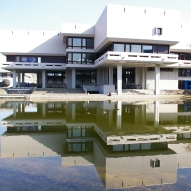| Dokumentenart: | Artikel | ||||
|---|---|---|---|---|---|
| Titel eines Journals oder einer Zeitschrift: | Inorganic Chemistry | ||||
| Verlag: | AMER CHEMICAL SOC | ||||
| Ort der Veröffentlichung: | WASHINGTON | ||||
| Band: | 55 | ||||
| Nummer des Zeitschriftenheftes oder des Kapitels: | 6 | ||||
| Seitenbereich: | S. 2840-2854 | ||||
| Datum: | 2016 | ||||
| Institutionen: | Chemie und Pharmazie > Institut für Anorganische Chemie > Lehrstuhl Prof. Dr. Manfred Scheer | ||||
| Identifikationsnummer: |
| ||||
| Stichwörter / Keywords: | ORGANIC HYBRID MATERIALS; METAL STRING COMPLEXES; TETRAPHOSPHINE LIGANDS; CRYSTAL-STRUCTURE; BASIS-SETS; STRUCTURAL-CHARACTERIZATION; TRIPHOSPHINE LIGANDS; SILVER(I) COMPLEXES; SANDWICH COMPLEXES; FULLERENE TOPOLOGY; | ||||
| Dewey-Dezimal-Klassifikation: | 500 Naturwissenschaften und Mathematik > 540 Chemie | ||||
| Status: | Veröffentlicht | ||||
| Begutachtet: | Ja, diese Version wurde begutachtet | ||||
| An der Universität Regensburg entstanden: | Ja | ||||
| Dokumenten-ID: | 42384 |
 Web of Science
Web of ScienceZusammenfassung
This study describes the selective synthesis of linear, trinuclear, halide-bridged Cu-I complexes [Cu-3(mu-X)(2)(mu-dpmp)(2)(MeCN)(2)](+) (1a: X = Cl; 1b: X = Br; 1c: X = I) stabilized by the tridentate dpmp ligand obtained by self -assembly reactions in THF/MeCN. Upon drying, the MeCN ligands can be removed and the complexes are transformed to the reactive parent trinuclear ...

Zusammenfassung
This study describes the selective synthesis of linear, trinuclear, halide-bridged Cu-I complexes [Cu-3(mu-X)(2)(mu-dpmp)(2)(MeCN)(2)](+) (1a: X = Cl; 1b: X = Br; 1c: X = I) stabilized by the tridentate dpmp ligand obtained by self -assembly reactions in THF/MeCN. Upon drying, the MeCN ligands can be removed and the complexes are transformed to the reactive parent trinuclear [Cu-3(mu-X)(2)(mu-dpmp)(2)](+) (2a-c) building blocks with two vacant coordination sites on the terminal Cu atoms. Another synthesis in CH2Cl2 directly yields 2a-c. Additionally, two related isomeric compounds, 2a* and 2c*, and two CH2Cl2-ligated complexes, [Cu-3(mu-X)(2)(mu-dpmp)(2)(CH2Cl2)(2)](+) (X = Br (3b), I (3c)), were structurally characterized. The frameworks of the cationic [Cu-3(mu-X)(2)(mu-dpmp)(2)](+) complexes are stable in solution at low temperatures and show dynamic coordination behavior at elevated temperatures, indicated by new signals arising in the P-31{H-1} NMR spectra. This evolution cannot be shifted back by decreasing the temperature again. However, cationic [Cu-3(mu-X)(2)(mu-dpmp)(2)](+) (X = Cl, Br, I) complexes can be obtained selectively in the solid state upon crystallization. Although reactions of 2a-c with complexes [{CpMo(CO)(2)}(2)(mu,eta(2):eta(2)-E-2)] (E = P (A1), As (A2)) led to unsymmetrically substituted [Cu-3(mu-X)(2)(mu-dpmp)(2)(eta(1)-L)](+) (4a-c: X = Cl-I, L = A1; 5: X = Cl, L = A2) complexes, reactions with the cyclo-P-3 complex [CpMo(CO)(2)(eta(3)-P-3)] (B) afforded zigzag chain polymers [Cu-3(mu-X)(2)(mu-dpmp)(2)(mu,eta(1):eta(1)-B)](n)[BF4](n) (6a: X = Cl; 6b: X = Br) and symmetrically substituted complex [Cu-3(mu-I)(2)(mu-dpmp)(2)(eta(1)-B)(2)](+) (7). Reactions of 2a-c with cyclo-E-5 complexes [Cp*Fe(eta(5)-E-5] (E = P (C1), As (C2)) led to the isolation of one-dimensional coordination polymers [Cu-3(mu-X)(2)(mu-dpmp)(2)(mu,eta(1):eta(1)-L)](n), [BF4](n) (8a-b: X = Cl-Br, L = C1; 9: X = Cl; L = C2) and symmetrically substituted complex [Cu-3(mu-I)(2)(mu-dpmp)(2)(eta(1)-C1)(2)](+) (10). All products exhibit a trinuclear, cationic [Cu-3(mu-X)(2)(mu-dpmp)(2)](+) complex as the central structural motif. Variation of the intramolecular Cu-Cu distances inside the Cu-3 complexes is discussed, and supporting DFT computations for the model complex [Cu-3(mu-Cl)(2)(dpmp)(2){(eta(1)-A1)}](+) (4a') are presented.
Metadaten zuletzt geändert: 17 Mrz 2020 11:28




 Altmetric
Altmetric